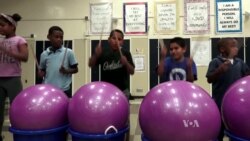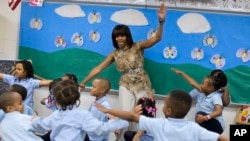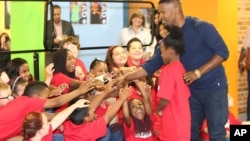In some of the lowest performing elementary and middle schools in the U.S., students are learning in an unconventional way.
“I like to act and I like to sing and I like to dance,” said 10-year-old Kayla Driakare, whose teachers at Florence Griffith Joyner Elementary School are incorporating much of what she loves doing into the everyday curriculum.
Her school is a part of a national program called Turnaround Arts, and is an initiative started by former first lady Michelle Obama.It aims to help improve low performing schools through the arts.
For Driakare and her classmates, their school is a safe haven from life outside its walls.The students at Florence Griffith Joyner Elementary are from Watts, a neighborhood in Los Angeles known for its gang violence.
“High crime, high poverty, very multigenerational families in public housing. There’s gun violence. We see a lot of helicopters and we have lockdowns regularly and so, the thing is, all associated with poverty – that really traumatized students, so many of our students come to school with symptoms of post-traumatic stress,” explained school principal Akida Kissane Long.
She remembers when she first started at the school five years ago, there was “willful disobedience, primarily fighting (and) destruction of school property.”
Long said the suspension rate was “267 suspensions on record and (there were) 1,167 classroom suspensions.“
The school performed in the lowest 5% of the state and qualified for the Turnaround Arts program, a public-private partnership led by the President’s Committee on the Arts and the Humanities and managed by the D.C.-based John F. Kennedy Center for the Performing Arts.
It is one of 68 schools in the U.S. participating in the program.Teachers receive special training, and the arts are incorporated into all the subjects.Turnaround Arts schools also partner with professional musicians and actors who work with the students. Among the names are Yo-Yo Ma, Sarah Jessica Parker, Elton John and Cameron Diaz.
“The children were so excited and have been so excited because it’s not just about – “Go to the board. Do the problem. Turn the page. Read the book.'It’s about acting and impersonating artists and historic figures, and acting out the water cycle and becoming a butterfly that goes from caterpillar through the cocoon to an expansive beautiful winged insect,” said Long.
On Thursdays, dedicated teachers in music and art give lessons.
“Art is fun. You get to draw what you draw and you get to draw something that you really like,” said an excited Driakare.
Only in the first year of a 3-year program, Long is already seeing results.
“We’ve probably suspended one kid this year. That’s amazing. Parents are getting phone calls to come to family portraiture night and come to family arts night, and it’s not just the naughty calls home. It’s for them to come and learn more about what their children are learning.So our parent engagement goes up,” Long said.
Decreased disciplinary actions, increased attendance and improved academic achievement are occurring nationwide in a 3-year program evaluation of pilot schools.From 2011 to 2014, the study found a 22.55% improvement in math proficiency and 12.62% improvement in reading proficiency in the Turnaround Arts pilot schools.The study also found Turnaround Arts schools performed better than comparable schools that received special grants for school improvement.
At a time when President Donald Trump is proposing cutting the budget for the arts, and arts education is being deemphasized as policy makers push for more focus on math and science in U.S. education, Long is making a case for a more holistic approach.
“Art speaks to everyone. Arts isn’t a set aside. It is part of what makes the curriculum rich and exciting and motivating.” Long added, “Because the arts is so universal and speaks across every culture and every language, every kid has an opportunity to access the highest levels of the curriculum because they had it delivered in a way that they could understand.”
At the end of the 3-year program, Long is asking the school district to turn this school into a visual and performing arts magnet school so it can get funding from the district to continue its focus on the arts, and allow more students to experience learning through a more creative approach.










